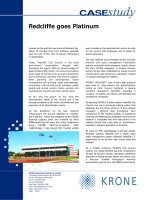Tài liệu Ten Ways Hackers Breach Security pdf
Bạn đang xem bản rút gọn của tài liệu. Xem và tải ngay bản đầy đủ của tài liệu tại đây (120.02 KB, 8 trang )
Ten Ways Hackers
Breach Security
1-800-COURSES
www.globalknowledge.com
Expert Reference Series of White Papers
Introduction
Hacking, cracking, and cyber crimes are hot topics these days and will continue to be for the foreseeable future.
However, there are steps you can take to reduce your organization's threat level. The first step is to understand
what risks, threats, and vulnerabilities currently exist in your environment. The second step is to learn as much
as possible about the problems so you can formulate a solid response. The third step is to intelligently deploy
your selected countermeasures and safeguards to erect protections around your most mission-critical assets. This
white paper discusses ten common methods hack
ers use to breach your existing security.
1. Stealing Passwords
Security experts have been discussing the problems with password security for years. But it seems that few
have listened and tak
en action to resolve those problems. If your IT environment controls authentication using
passwords only, it is at greater risk for intrusion and hacking attacks than those that use some form of multi-
factor authentication.
The problem lies with the ever-increasing abilities of computers to process larger amounts of data in a smaller
amount of time. A password is just a string of characters, typically only keyboard characters, which a person
must remember and type into a computer terminal when required. Unfortunately, passwords that are too com-
plex for a person to remember easily can be discovered by a cracking tool in a frighteningly short period of
time. Dictionary attacks, brute force attacks, and hybrid attacks are all various methods used to guess or crack
passwords. The only real protection against such threats is to make very long passwords or use multiple factors
for authentication. Unfortunately, requiring ever longer passwords causes a reversing of security due to the
human factor. People simply are not equipped to remember numerous long strings of chaotic characters.
But even with reasonably long passwords that people can remember, such as 12 to 16 characters, there are
still other problems facing password-only authentication systems
.
T
hese include:
• People who use the same password on multiple accounts, especially when some of those accounts are
on public Internet sites with little to no security.
•
P
eople who write their passwords down and store them in obvious places
. Writing down passwords is
often encouraged by the need to frequently change passwords.
• The continued use of insecure protocols that transfer passwords in clear text, such as those used for
Web surfing, e-mail, chat, file transfer, etc.
• The threat of software and hardware keystroke loggers.
• The problem of shoulder surfing or video surveillance.
James Michael Steward, Global Knowledge Instructor
Ten Ways Hackers Breach Security
Copyright ©2007 Global Knowledge T
raining LLC. All rights reserved.
Page 2
P
assword theft, password cracking, and even password guessing are still serious threats to IT environments.
The best protection against these threats is to deploy multifactor authentication systems and to train person-
nel regarding safe password habits.
2.Trojan Horses
A Trojan horse is a continuing threat to all forms of IT communication. Basically, a Trojan horse is a malicious
payload surreptitiously delivered inside a benign host. You are sure to have heard of some of the famous
Trojan horse malicious payloads such as Back Orifice, NetBus, and SubSeven. But the real threat of Trojan hors-
es is not the malicious payloads you know about, its ones you don't. A Trojan horse can be built or crafted by
anyone with basic computer skills. Any malicious payload can be combined with any benign software to create
a Trojan horse. There are countless ways of crafting and authoring tools designed to do just that. Thus, the real
threat of Trojan horse attack is the unknown.
The malicious payload of a Trojan horse can be anything. This includes programs that destroy hard drives, cor-
rupt files, record keystrokes, monitor network traffic, track Web usage, duplicate e-mails, allow remote control
and remote access
, transmit data files to others, launch attacks against other targets, plant proxy servers, host
file sharing services, and more. Payloads can be grabbed off the Internet or can be just written code authored
by the hacker. Then, this payload can be embedded into any benign software to create the Trojan horse.
Common hosts include games, screensavers, greeting card systems, admin utilities, archive formats, and even
documents.
All a Trojan horse attack needs to be successful is a single user to execute the host program. Once that is
accomplished, the malicious payload is automatically launched as well, usually without any symptoms of
unwanted activity. A Trojan horse could be delivered via e-mail as an attachment, it could be presented on a
Web site as a download, or it could be placed on a removable media (memory card, CD/DVD, USB stick, floppy,
etc.). In any case, your protections are automated malicious code detection tools, such as modern anti-virus
protections and other specific forms of malware scanners, and user education.
3. Exploiting Defaults
Nothing mak
es attacking a target network easier than when that target is using the defaults set by the vendor
or manufacturer. Many attack tools and exploit scripts assume that the target is configured using the default
settings
.
T
hus
,
one of the most effective and often overlooked security precautions is simply to change the
defaults.
To see the scope of this problem, all you need to do is search the Internet for sites using the keywords "default
passwords". There are numerous sites that catalog all of the default user names, passwords, access codes, set-
tings
,
and naming conventions of every softw
are and hardw
are IT product ever sold.
It is your responsibility to
know about the defaults of the products you deploy and mak
e every effort to change those defaults to non-
obvious alternatives.
But it is not just account and password defaults you need to be concerned with, there are also the installation
defaults such as path names, folder names, components, services, configurations, and settings. Each and every
possible customizable option should be considered for customization.
T
ry to avoid installing operating systems
into the default drives and folders set by the vendor
.
Don't install applications and other software into their
"standard" locations. Don't accept the folder names offered by the installation scripts or wizards. The more
Copyright ©2007 Global Knowledge T
raining LLC. All rights reserved.
Page 3
y
ou can customize your installations, configurations, and settings, the more your system will be incompatible
with attack tools and exploitation scripts.
4. Man-in-the-Middle Attacks
Every single person reading this white paper has been a target of numerous man-in-the-middle attacks. A
MITM attack occurs when an attacker is able to fool a user into establishing a communication link with a serv-
er or service through a rogue entity. The rogue entity is the system controlled by the hacker. It has been set up
to intercept the communication between user and server without letting the user become aware that the mis-
direction attack has taken place. A MITM attack works by somehow fooling the user, their computer, or some
part of the user's network into re-directing legitimate traffic to the illegitimate rogue system.
A MITM attack can be as simple as a phishing e-mail attack where a legitimate looking e-mail is sent to a user
with a URL link pointed towards the rogue system instead of the real site. The rogue system has a look-alike
interface that tricks the user into providing their logon credentials. The logon credentials are then duplicated
and sent on to the real server. This action opens a link with the real server, allowing the user to interact with
their resources without the knowledge that their communications have tak
en a detour through a malicious
system that is eavesdropping on and possibly altering the traffic.
MITM attacks can also be waged using more complicated methods, including MAC (Media Access Control)
duplication, ARP (Address Resolution Protocol) poisoning,
router table poisoning, fake routing tables
, DNS
(Domain Name Server) query poisoning,
DNS hijacking, rogue DNS servers, HOSTS file alteration, local DNS
cache poisoning, and proxy re-routing. And that doesn't mention URL obfuscation, encoding, or manipulation
that is often used to hide the link misdirection.
To protect yourself against MITM attacks, you need to avoid clicking on links found in e-mails. Furthermore,
always verify that links from Web sites stay within trusted domains or still maintain SSL encryption. Also,
deploy IDS (Intrusion Detection System) systems to monitor network traffic as well as DNS and local system
alterations.
5.Wireless Attacks
Wireless networks have the appeal of freedom from wires - the ability to be mobile within your office while
maintaining network connectivity
.
Wireless networks are inexpensive to deploy and easy to install.
Unfortunately, the true cost of wireless networking is not apparent until security is considered. It is often the
case that the time, effort, and expense required to secure wireless networks is significantly more than deploy-
ing a traditional wired network.
Interference
,
DOS
,
hijacking,
man-in-the-middle, eavesdropping, sniffing, and many more attacks are made sim-
ple for attack
ers when wireless networks are present.
T
hat doesn't even mention the issue that a secured
wireless network (802.11a or 802.11g) will typically support under 14 Mbps of throughput, and then only
under the most ideal transmission distances and conditions. Compare that with the standard of a minimum of
100 Mbps for a wired network, and the economy just doesn't make sense.
However
,
even if your organization does not officially sanction and deploy a wireless network,
you may still
have wireless network vulnerabilities
.
Many organizations have discovered that workers have taken it upon
themselves to secretly deploy their own wireless network. They can do this by bringing in their own wireless
Copyright ©2007 Global Knowledge T
raining LLC. All rights reserved.
Page 4
a
ccess point (WAP), plugging in their desktop's network cable into the WAP, then re-connecting their desktop
to one of the router/switch ports of the WAP. This retains their desktop's connection to the network, plus it
adds wireless connectivity. All too often when an unapproved WAP is deployed, it is done with little or no
security enabled on the WAP. Thus, a $50 WAP can easily open up a giant security hole in a multi-million dollar
secured-wired network.
To combat unapproved wireless access points, a regular site survey needs to be performed. This can be done
with a notebook using a wireless detector such as NetStumbler or with a dedicated hand-held device.
6. Doing their Homework
I don't mean that hackers break into your network by getting their school work done, but you might be sur-
prised how much they learn from school about how to compromise security. Hackers, especially external
hackers, learn how to overcome your security barriers by researching your organization. This process can be
called reconnaissance, discovery, or footprinting. Ultimately, it is intensive, focused research into all information
available about your organization from public and non-so-public resources.
If you've done any research or reading into warfare tactics, you are aware that the most important weapon
you can have at your disposal is information. Hackers know this and spend considerable time and effort
acquiring a complete arsenal. What is often disconcerting is how much your organization freely contributes to
the hacker's weapon stockpile
. Most organizations are hemorrhaging data; companies freely give aw
ay too
much information that can be used against them in v
arious types of logical and physical attacks. Here are just
a few common examples of what a hacker can learn about your organization, often in minutes:
• The names of your top executives and any flashy employees you have by perusing your archive of press
releases.
• The company address, phone number, and fax number from domain name registration.
• The service provider for Internet access through DNS lookup and traceroute.
• Employee home addresses, phone numbers, employment history, family members, previous addresses,
criminal record, driving history, and more by looking up their names in various free and paid background
research sites.
• The operating systems, major programs, programming languages, specialized platforms, network device
vendors, and more from job site postings.
• Physical weaknesses, vantage points, lines of sight, entry ways, covert access paths, and more from
satellite images of your company and employee addresses.
• Usernames, e-mail addresses, phone numbers, directory structure, filenames, OS type, Web server plat-
form,
scripting languages, Web application environments, and more from Web site scanners.
• Confidential documents accidentally posted to a Web site from archive.org and Google hacking.
•
Flaws in your products
,
problems with staff
,
internal issues
,
company politics
,
and more from blogs,
product reviews, company critiques, and competitive intelligence services.
As you can see
,
there is no end to the information that a hacker can obtain from public open sources. This list
of examples is only a beginning. Each kernel of truth discovered often leads the hacker to unearth more. Often,
a hacker will spend over 90% of their time in information-gathering activities. The more the attacker learns
about the target,
the easier the subsequent attack becomes
.
As for defense, you are ultimately at a loss—mainly because it is already too late. Once information is out on
the Internet,
it is always out there. You can obviously clean up and sterilize any information resource currently
Copyright ©2007 Global Knowledge T
raining LLC. All rights reserved.
Page 5









